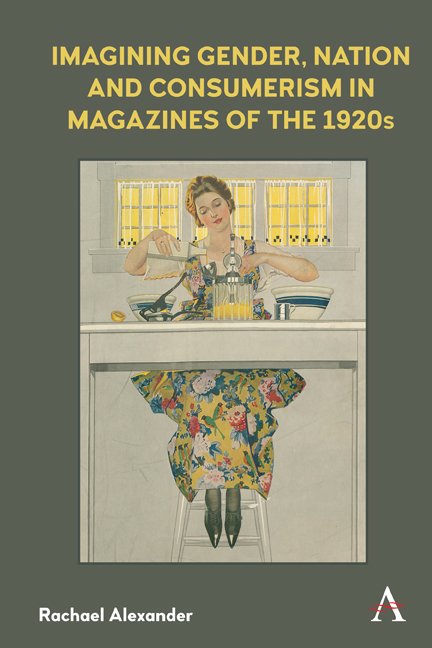Book contents
- Frontmatter
- Dedication
- Contents
- List of Illustrations
- Acknowledgements
- Introduction
- 1 Two Home Journals: A Comparative Approach
- 2 The Art of Femininity: Aspiration and Self-Improvement
- 3 The Home and Domesticity: Readers, Consumers, Citizens
- 4 Fashionable, Beautiful, Moral: Idealised Images of Femininity
- Conclusion
- Appendix: Content Analysis of Advertising from the Ladies’ Home Journal and Canadian Home Journal
- Notes
- References
- Index
- Frontmatter
- Dedication
- Contents
- List of Illustrations
- Acknowledgements
- Introduction
- 1 Two Home Journals: A Comparative Approach
- 2 The Art of Femininity: Aspiration and Self-Improvement
- 3 The Home and Domesticity: Readers, Consumers, Citizens
- 4 Fashionable, Beautiful, Moral: Idealised Images of Femininity
- Conclusion
- Appendix: Content Analysis of Advertising from the Ladies’ Home Journal and Canadian Home Journal
- Notes
- References
- Index
Summary
In the first place, this magazine, as a whole, stands for and expresses through its printed pages the highest ideals of womanhood – culture, refinement, education […] [It] will give any woman, even though her reading be limited to this one magazine, splendid assistance in her natural vocation of building that greatest of institutions, the Home.
– Ladies’ Home Journal, March 1922The appeal of the Canadian Home Journal lies primarily in the facts that it is devoted to the interests of the home, and that it is thoroughly Canadian.
– Canadian Home Journal, June 1926As James Mussell comments, ‘The logic of print is repetition, and of all print genres it is the serial that embodies this most fully’ (‘Repetition’ 345). In this spirit, we return to these two excerpts, included at the start of the introduction to this book. They are representative of the intentions and interests championed by the Ladies Home Journal and Canadian Home Journal, repeated throughout each issue of the 1920s and beyond. The primacy of ‘ideals of womanhood’ and ‘interests of the home’ remains apparent throughout. Indeed, the two are crucially interlinked. Yet this perhaps implies a level of fixedness in ideals and aims which is challenged by closer interrogation of each title. While the idealised version, and vision, of femininity presented to the readership remained the aspirational modern housewife, this ideal was not static and presented contradictions to be negotiated as often as it did a blueprint for self-improvement. The deployment of the ideal can be seen to mask, but certainly not efface, some of the contradictions, threats and anxieties which modernity presented to middle-class femininity. To push this line of thinking slightly further, it may be the case that this was the underlying purpose of the women's magazine: to reinforce an accepted and acceptable femininity. Even if this was true, this was not the women's magazine's only function. To return to Caroline Levine's use of the concept of ‘affordances’, these magazines can be regarded as products which afford multiple, at times unexpected, uses and functions. Perhaps the most notable of these are the ways in which each title provided a space for the negotiation of accepted and acceptable performances of femininity.
- Type
- Chapter
- Information
- Publisher: Anthem PressPrint publication year: 2021



